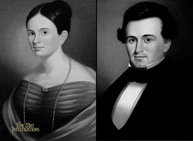Rediscovered Bingham Portraits: Connoisseurship
Introduction
Provenance and art historical research strongly suggested that family lore was true: George Caleb Bingham painted the heirloom portraits of William Franklin Dunnica and his wife, Martha Jane Shackelford. (See Rediscovered Bingham Portraits: The Dunnicas, Part 1). Would connoisseurship confirm or deny that the portrait pair were rediscovered paintings by Bingham?
Context
According to art historical research, Bingham painted the portraits between 1836 and 1839, when the subjects, William Franklin Dunnica (1807-1883) and his wife Mary Jane Shackelford (1820-1858) lived in Chariton (now Glasgow), Missouri, about 20 miles northeast of George Caleb Bingham’s hometown of Arrow Rock, Missouri. Bingham is known to have portrayed at least 10 Chariton / Glasgow residents during those years. He painted some in the fall of 1837; others, after a two-month visit to Philadelphia in spring 1838. The latter portraits show sophisticated techniques such as more fluid brushwork and increasingly flattering poses. (See the comparisons of the two paintings of Mary Jane Shackelford Dunnica in link to Correcting an Art Historical Mistake.) Below are images of 8 of those 10 paintings compared with images of the Dunnica portraits.
Comparisons
The similarities of Bingham’s Glasgow portraits to the portraits of the Dunnicas are, in my opinion, unmistakable. The Cockerill portraits may have been painted earlier than the others. Without having seen the paintings in person, they look stiffer than the others, more akin to Bingham’s earlier work before his visit to St. Louis. That, impression, however, could be a result of the photographs.
At first glance, the Belden portraits (cropped) and the Swinney portraits look nearly identical to those of the Dunnicas. William Dunnica and William Swinney were partners in the tobacco trade. Joshua Belden was William Swinney’s secretary. In the three portrait pairs, the height of the men’s shirt collars touch their chins. The lengths of their sideburns are comparable. All three women wear quite similar hairstyles. This conformity to the fashions indicates that all six portraits were painted around the same time. Hair, eyebrows, eyes, and ears, to the manner in which the artist tinted the cheeks, shadowed the face, the nose, and the necks of the women are all the same.

George Caleb Bingham, Emma Donohoe (Mrs. Thomas Nicholas Cockerill), 1836/7
Oil on Canvas, 29 x 24 inchesGilcrease Museum, Tulsa, Oklahoma 01.2490
George Caleb Bingham, Thomas Nicholas Cockerill), 1836/7
Oil on Canvas, 29 x 24 inchesGilcrease MuseumTulsa, Oklahoma 01.2489
Links to color images at Gilcrease Museum of Dr. Thomas Cockerill and Emma Cockerill.

George Caleb Bingham, Agnes Elizabeth Lewis (Mrs. Joshua Belden), ca. 1837
Oil on canvas, 29 x 23 inches Private Collection (Cropped)
George Caleb Bingham, Joshua Belden, ca. 1837
Oil on canvas, 29 x 23 inches Private Collection (Cropped)

George Caleb Bingham, Lucy Ann Jones (Mrs. Willliam Daniel Swinney), ca. 1837-1838
Oil on canvas, 36 x 28 inchesPresent location unknown
George Caleb Bingham, Captain William Daniel Swinney, ca. 1837-1838
Oil on canvas, 36 x 28 inchesPresent location unknown
George Caleb Bingham, Martha Jane Shackelford, (Mrs. William Franklin Dunnica), ca. 1837
Oil on Canvas, 24 x 29 inches Private Collection
George Caleb Bingham, William Franklin Dunnica, ca. 1837
Oil on Canvas, 24 x 29 inches Private Collection
Conclusion
Since the examples are known and accepted works by George Caleb Bingham, then the Dunnica portraits, not only logically, but through style and technique were, in my opinion, and that of Maryellen McVicker, painted by George Caleb Bingham. Do you have any doubts that the artist was Bingham?

